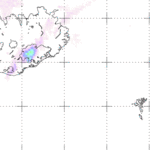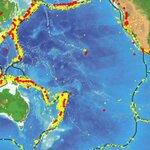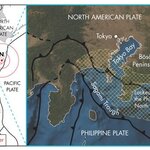Geology

By tracking seismic shifts, researchers say they may be able to predict a major quake off the coast of Istanbul.
When a segment of a major fault line goes quiet, it can mean one of two things - an inactive “seismic gap” which is the result of two tectonic plates placidly gliding past each other, or the seismic gap may be filled by an earthquake after quietly building tension for decades.
Researchers say they have found evidence for both types of behavior on different segments of the North Anatolian Fault — one of the most energetic earthquake zones in the world. The fault, similar in scale to…

ESA Satellites are showing clouds of sulfur dioxide exiting from Iceland’s Bardarbunga volcano.
It may be mostly hidden underneath the Vatnajokull glacier in the center of the country but Bardarbunga isn't shy about saying hello, it has had up to 400 eruptions in the last 10,000 years, one of which produced more lava than any other volcano on Earth during that time.
23 of those were geologically recent.
Bardarbunga eruptions seem to happen even more often than colony collapse disorders in bees, so Iceland knows it's best not to get too complacent when something sitting on two volcanic rift…

Researchers say that magma columns in the Earth's interior can cause continental breakup – under the right circumstances.
In some parts of the Earth, material rises upwards like a column from the boundary layer of the Earth's core and the lower mantle to just below the Earth's crust hundreds of kilometers above. Halted by the resistance of the hard crust and lithospheric mantle, the flow of material becomes wider, taking on a mushroom-like shape. Specialists call these magma columns mantle plumes or simply plumes.
Geologists believe that plumes are not just responsible for creating volcanoes…

The rise of the Tibetan plateau, the largest topographic anomaly above sea level on Earth, is important for both its profound effect on climate and its reflection of continental dynamics.
For a new study, Katharine Huntington and colleagues employed a cutting-edge geochemical tool - "clumped" isotope thermometry - using modern and fossil snail shells to investigate the uplift history of the Zhada basin in southwestern Tibet.
Views range widely on the timing of surface uplift of the Tibetan Plateau to its current high (~4.5 km) over more than 2.5 square kilometers. Specifically,…

The tectonic plate that dominates the Pacific "Ring of Fire" is not as rigid as most assume, and it's getting less fiery. according to researchers at Rice University and the University of Nevada.
Rice geophysicist Richard Gordon and Corné Kreemer, an associate professor at the University of Nevada, Reno, have determined that cooling of the lithosphere -- the outermost layer of Earth -- makes some sections of the Pacific plate contract horizontally at faster rates than others and cause the plate to deform. Gordon said the effect detailed is most pronounced in the youngest parts of…

The makeup of the Earth's lower mantle, which makes up the largest part of the Earth by volume, is significantly different than previously thought.
Though understanding the composition of the mantle is essential to seismology, the study of earthquakes and movement below the Earth's surface, and could shed light on unexplained seismic phenomena observed there, little is actually known. Every few months a new estimate about the mantle is produced.
The lack of knowledge is because humans haven't yet managed to drill further than seven and a half miles into the Earth, so geologists rely on…

Global warming has been implicated in many things, it is certainly being implicated in the latest drought in California, the worst since 2002, which was the worst since the early 1990s -and now it is being linked to a change in tectonic plates.
Scientists at Scripps Institution of Oceanography at U.C. San Diego say that the loss of water is causing the entire western U.S. to rise up like an uncoiled spring.
Investigating ground positioning data from GPS stations throughout the west, Scripps researchers Adrian Borsa, Duncan Agnew, and Dan Cayan found that the water shortage is causing an "…

Water has been detected on Mars
in the form of permafrost and there is strong evidence that liquid water was a major component of the martian surface in the past.
Clays are an important mineral group for discovering the past on Mars, not only to the presence of water, since clays are hydrous minerals, but they also provide clues as to the source, type, and volume of fluids, along with indications of timescale and mineral alteration. If you are going to search for textural and chemical biosignatures, clay is a good place to start.
A conspicuous biomorphic ovoid structure has been discovered in…

Nearly forgotten research from decades ago complicates the task of quantifying earthquake hazards in the Pacific Northwest, according to a new report.
The report focuses on the Cascadia subduction zone—a giant active fault that slants eastward beneath the Pacific coast of southern British Columbia, Washington, Oregon, and northern California.
Geologic studies in the past three decades have provided increasingly specific estimates of Cascadia earthquake sizes and repeat times. The estimates affect public safety through seismic provisions in building design and tsunami limits on evacuation…

Tokyo is a city of more than 13 million people and they are no strangers to earthquakes. The city, like much of Japan, has been devastated by earthquakes in the past and likely will be again - but when?
Ongoing slow-slip earthquakes can't usually be felt at the surface but they play a role in relieving or building up geological stress and recent research examining plate movements under Tokyo has found that, since the massive magnitude-9 Tohoku earthquake and tsunami in March 2011, recurrence intervals for non-damaging slow-slip quakes beneath Japan's capital have shortened.
This has…